Attached files
| file | filename |
|---|---|
| 8-K - 8-K - QUESTCOR PHARMACEUTICALS INC | d658915d8k.htm |
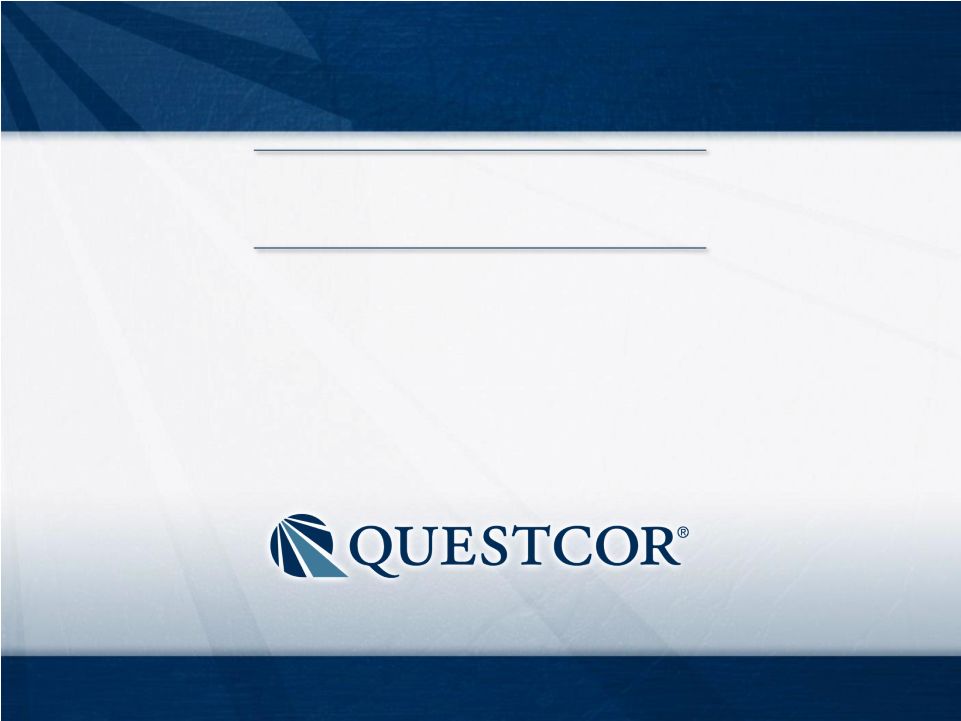 NASDAQ:
QCOR
J.P. Morgan
Healthcare Conference
January 16, 2014
Exhibit 99.1 |
 Safe
Harbor Statement 2
Note: Except for the historical information contained herein, this press release contains
forward-looking statements that have been made pursuant to the Private Securities
Litigation Reform Act of 1995. These statements relate to future events or our future financial performance. These statements are only
predictions. Actual events or results may differ materially. Factors that could cause or contribute to
such differences include, but are not limited to, the following: Our reliance on Acthar for
substantially all of our net sales and profits; Reductions in vials used per prescription resulting from changes in
treatment regimens by physicians or patient compliance with physician recommendations; Our ability to
receive high reimbursement levels from third party payers; The complex nature of our
manufacturing process and the potential for supply disruptions or other business disruptions; The lack of patent
protection for Acthar and the possible FDA approval and market introduction of competitive products;
Our ability to continue to generate revenue from sales of Acthar to treat on-label
indications associated with NS, MS, IS or rheumatology-related conditions, and our ability to develop other therapeutic
uses for Acthar; Research and development risks, including risks associated with Questcor's work in
the area of NS and Lupus, our efforts to develop and obtain FDA approval of Synacthen, our
reliance on third-parties to conduct research and development and the ability of research and development to
generate successful results; The results of any pending or future litigation, investigations or
claims, including government investigations and private securities litigation; Our ability to
comply with federal and state regulations, including regulations relating to pharmaceutical sales and marketing practices;
Regulatory changes or other policy actions by governmental authorities and other third parties in
connection with U.S. health care reform or efforts to reduce federal and state government
deficits; An increase in the proportion of our Acthar unit sales comprised of Medicaid-eligible patients and
government entities; Our ability to estimate reserves required for Acthar used by government entities
and Medicaid-eligible patients and the impact that unforeseen invoicing of historical
Medicaid prescriptions may have upon our results; Our ability to effectively manage our growth, including the expansion
of our sales forces, planned international expansion, and our reliance on key personnel; Our ability
to integrate the BioVectra business with our business and to manage, and grow, a contract
manufacturing business; Our ability to comply with foreign regulations related to the operating of BioVectra's
business and the international sales of Synacthen; The impact to our business caused by economic
conditions; Our ability to protect our proprietary rights; The risk of product liability
lawsuits; Our ability to successfully enter into, and operate in, international markets; The risk of unfavorable changes in currency
exchange rates; Unforeseen business interruptions and security breaches; Volatility in Questcor's
Acthar shipments, estimated channel inventory, and end-user demand, as well as volatility
in our stock price; Our ability and willingness to continue to pay our quarterly dividend or make future increases in
our quarterly dividend; and Other risks discussed in Questcor's annual report on Form 10-K for the
year ended December 31, 2012 as filed with the Securities and Exchange Commission, or SEC, on
February 27, 2013, and other documents filed with the SEC. The
risk factors and other information contained in these documents should be considered in evaluating Questcor's prospects
and future financial performance. |
 Questcor
A biopharmaceutical company focused on the treatment
of patients with serious, difficult-to-treat autoimmune
and inflammatory disorders
3 |
 Flagship product H.P. Acthar Gel has a unique
therapeutic role and sustainable competitive advantages
Acthar is approved for 19 indications, many in markets
with sizable unmet need
Market penetration remains modest;
sales have increased rapidly
Increasing investment in R&D to grow the
body of evidence and diversify
Profitable, strong cash flow and balance sheet; returned
cash to shareholders through buybacks and dividends
Investment Highlights
4 |
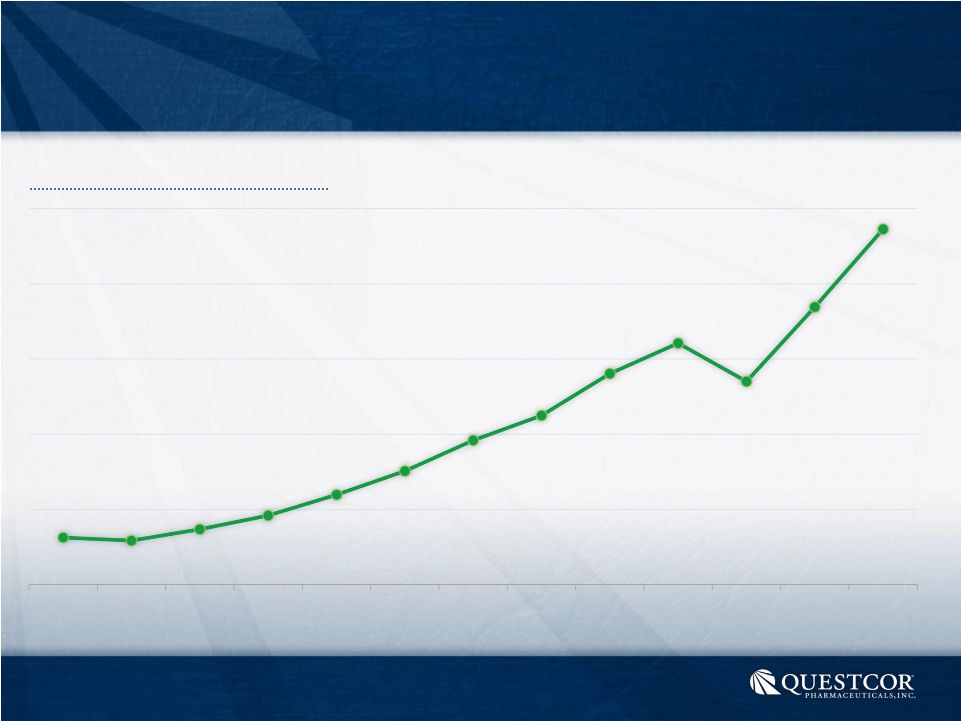 3-Year Net Sales
5
Quarterly Net Sales ($M)
$29.3
$46.0
$75.5
$112.5
$160.5
$184.6
$236.3
$31.3
$36.8
$59.8
$96.0
$140.3
$135.1
Q3 '10
Q4 '10
Q1 '11
Q2 '11
Q3 '11
Q4 '11
Q1 '12
Q2 '12
Q3 '12
Q4 '12
Q1 '13
Q2 '13
Q3 '13 |
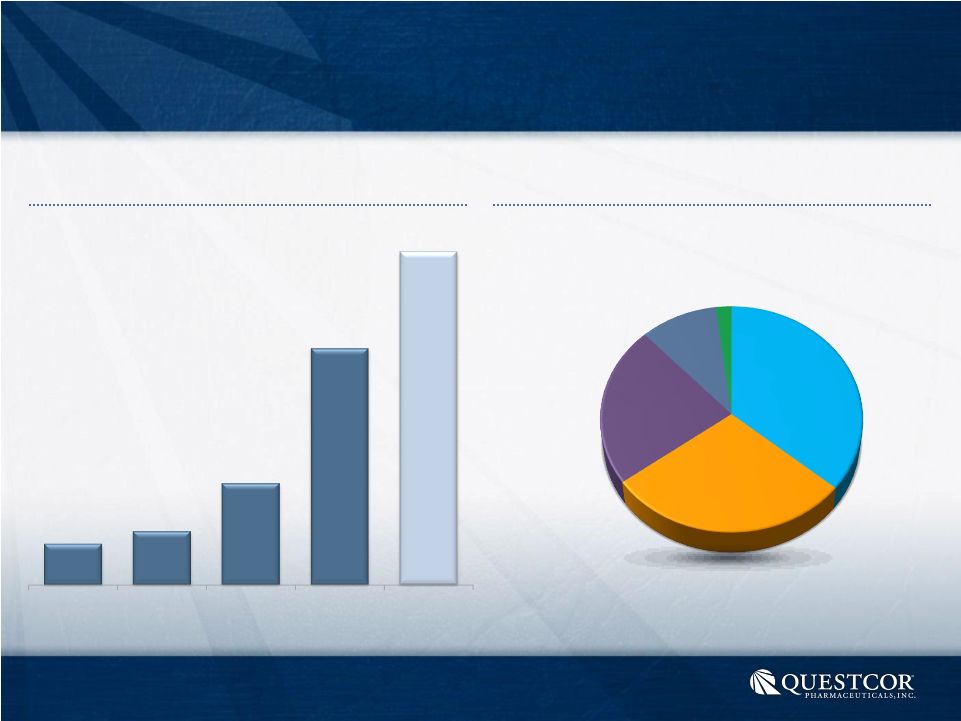 Acthar Business Diversification Continues
Rheumatology
20%-25%
Nephrology
30%-35%
Infantile Spasms
7%-12%
Other
~2%
MS
25%-30%
Acthar Estimated % Net Sales by
Therapeutic Area (Q3 2013)
Net Sales
($M)
6
TTM 2013: Trailing twelve months through September 30, 2013
$88
$115
$218
$509
$717
2009
2010
2011
2012
TTM 2013 |
 Expanding Acthar Sales
Across Therapeutic Areas
Acthar Net Sales ($M)
7
$88
$115
$218
$509
$717
*Numbers
on
the
bar
graph
represent
actual
Acthar
net
sales.
The
underlying
allocation
of
Acthar
net
sales
is
based
on
Management’s internal estimates;
TTM 2013: Trailing twelve months through September 30, 2013
Infantile Spasms
Multiple Sclerosis
Nephrology
Rheumology
Other
2009
2010
2011
2012
TTM 2013 |
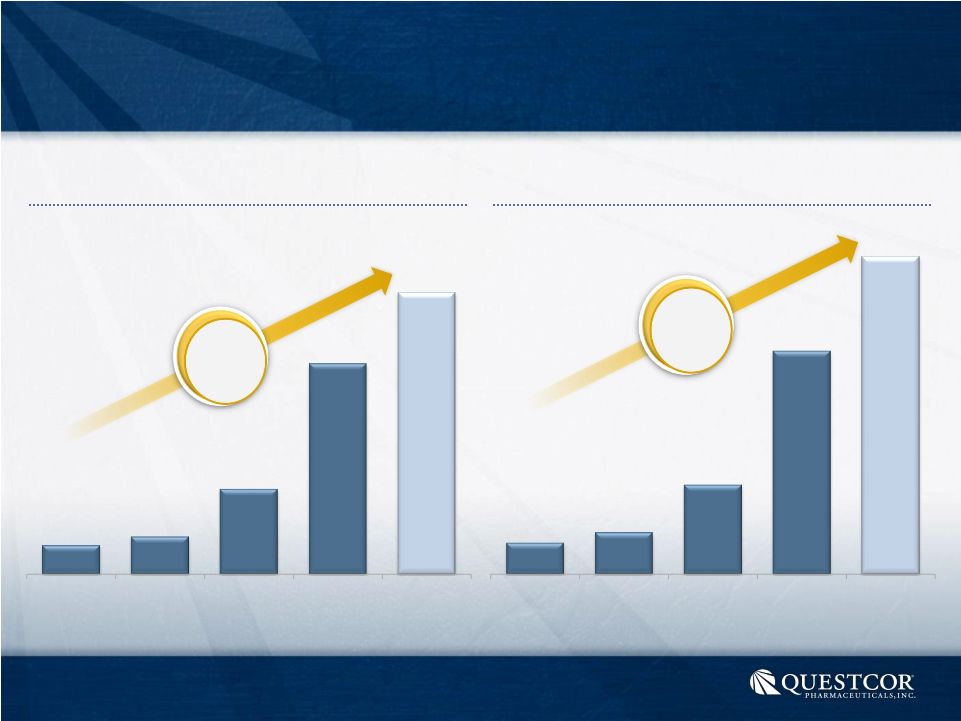 Net
Income Growth Non-GAAP
Net
Income
GAAP
Net
Income
8
TTM
2013:
Trailing
twelve
months
through
September
30,
2013;
See
reconciliation
table
in
Appendix
CAGR
77%
CAGR
79%
$27
$35
$80
$198
$265
$29
$39
$84
$210
$299
2009
2010
2011
2012
TTM 2013
2009
2010
2011
2012
TTM 2013
($M)
($M) |
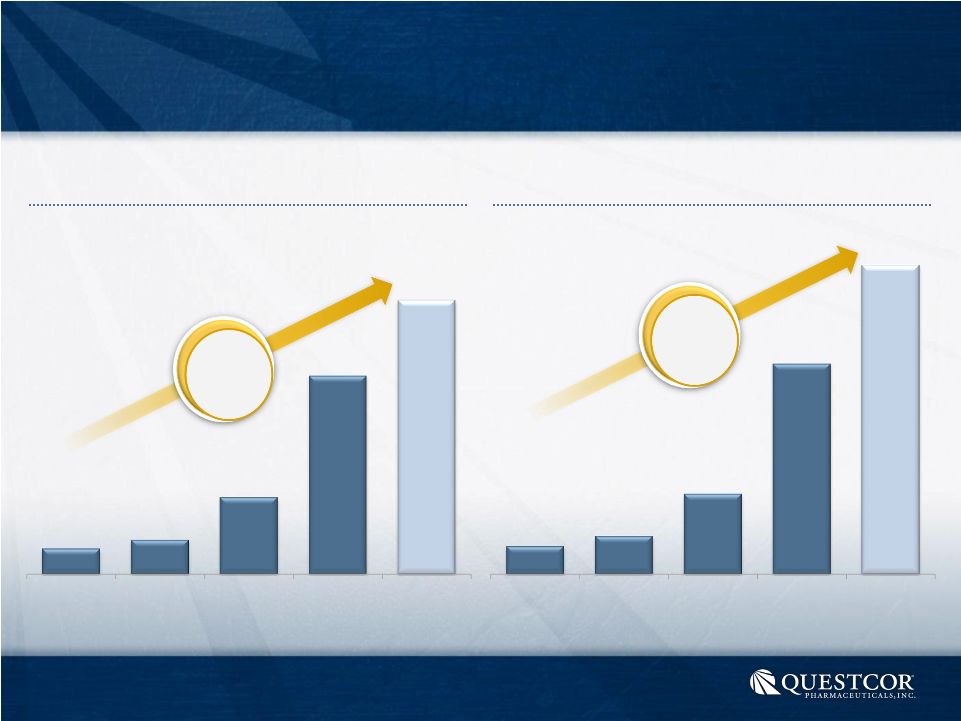 Earnings Growth
Non-GAAP Diluted EPS
GAAP Diluted EPS
9
TTM
2013:
Trailing
twelve
months
through
September
30,
2013;
See
reconciliation
table
in
Appendix
CAGR
81%
CAGR
83%
2009
2010
2011
2012
TTM 2013
$0.40
$0.54
$1.21
$3.14
$4.34
2009
2010
2011
2012
TTM 2013
$0.44
$0.60
$1.27
$3.33
$4.89 |
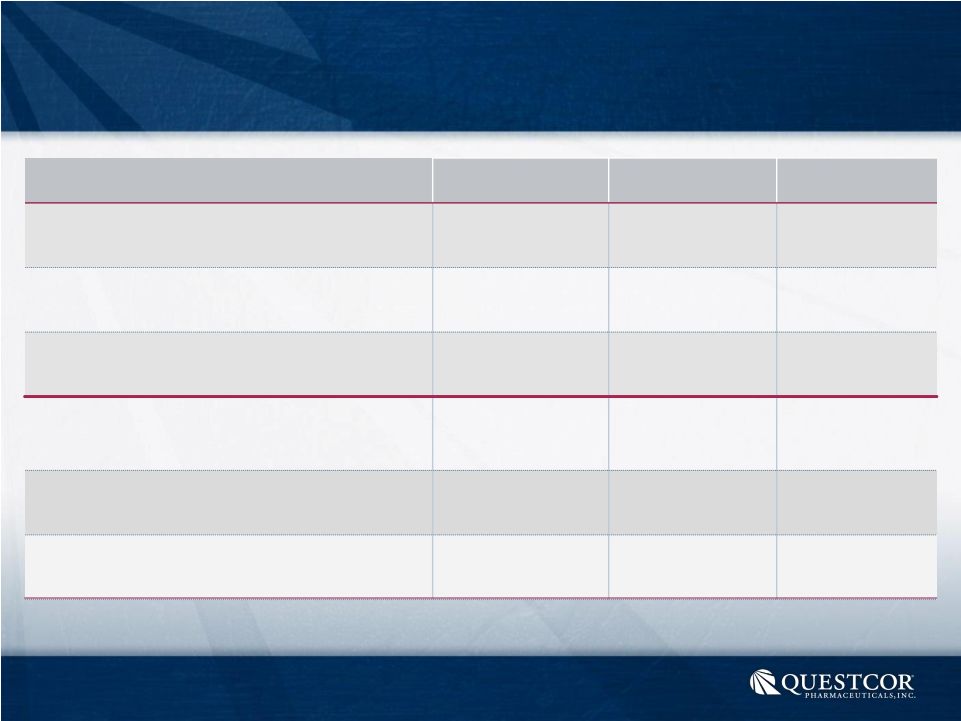 Q3-2013 Financial Results
10
* Includes $75 million in restricted cash. See reconciliation table in
Appendix Q3 –
2012
Change
Net Sales ($M)
$140.3
68%
Fully Diluted, GAAP EPS
$1.52
$0.91
$1.68
$0.97
73%
Investments ($M)
$281.1*
Cash Flow from Operations ($M)
$108.9
Diluted Shares Outstanding
62.1
61.4
Fully Diluted, Non-GAAP EPS
Cash and Short Term
$236.3
Q3 –
2013
$111.9
$51.2
67% |
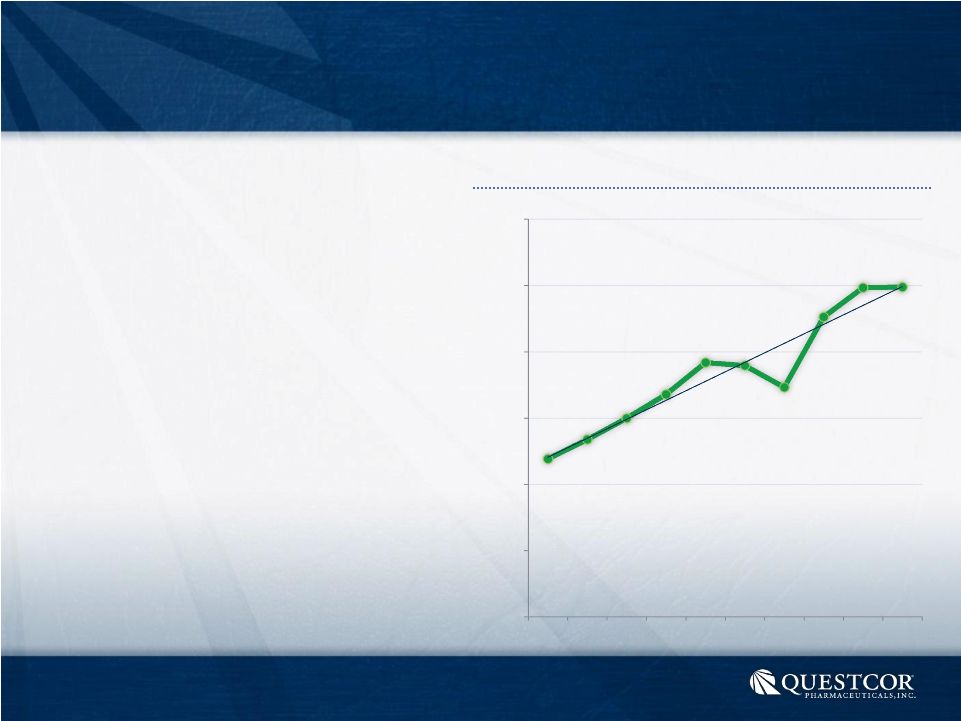 Recent Updates and Trends
11
Total Paid Acthar Rxs
•
$0.30 Dividend declared Q413
–
Record date: 1/17/14
–
Distribution date: 1/24/14
•
960K shares repurchased in Q413
•
$320M in Cash and ST Investments*
•
Board level Science and Strategic
Advisory Committees formed
–
To assist in ongoing evaluation of
factors contributing to the persistent
and significant discount in the
Company’s valuation relative to its
peer companies
–
Will also assess potential strategic
alternatives to address these
factors
*As of December 31, 2013 (includes $75M of restricted cash)
-
500
1,000
1,500
2,000
2,500
3,000
Q3-11
Q4-11
Q1-12
Q2-12
Q3-12
Q4-12
Q1-13
Q2-13
Q3-13
Q4-13 |
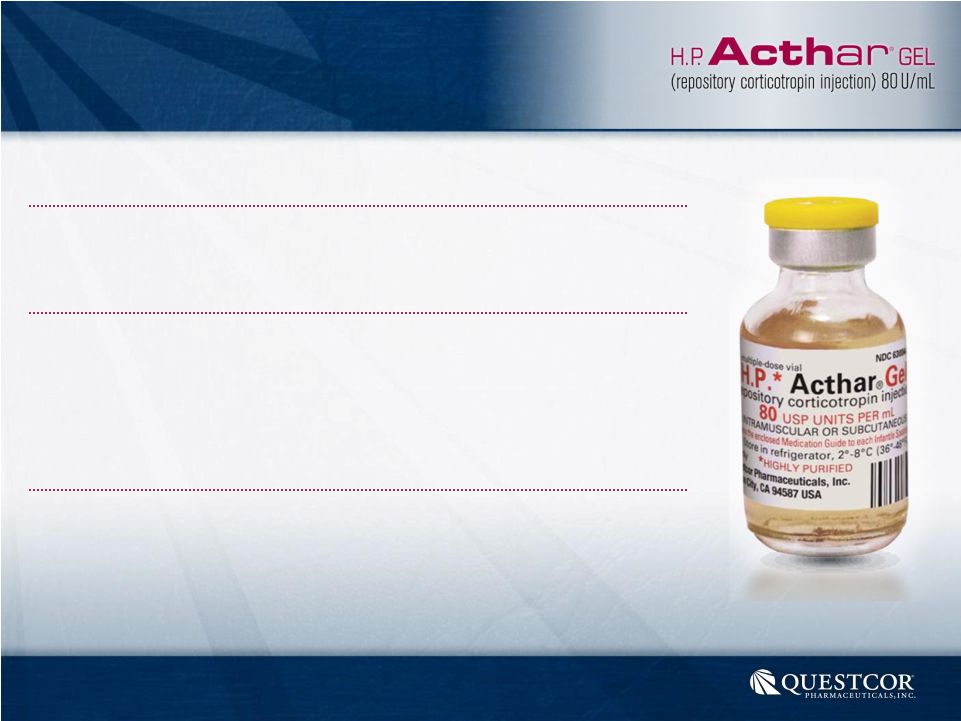 Flagship Product:
•
19 approved indications
Key Therapeutic Areas:
•
Nephrotic Syndrome, Multiple Sclerosis Relapse, Infantile Spasms,
Rheumatology Indications, Symptomatic Sarcoidosis
•
Significant areas of unmet need; large growth potential
Strategy:
•
Expand awareness, appropriate use of Acthar in key specialties
•
Develop Rheumatology and other on-label indications
Acthar Overview
12
*In
this
presentation,
the
terms
“Nephrotic
Syndrome,”
“Multiple
Sclerosis
Relapse,”
“Infantile
Spasms,”
“Rheumatology
Indications,”
and
“Symptomatic
Sarcoidosis,”
and
their
abbreviations,
refer
to
on-label
indications
for
Acthar
associated
with
such
conditions.
Investors should refer to the FDA approved Acthar label, which can be found at http://www.acthar.com/files/Acthar-PI.pdf |
 Nephrotic Syndrome
iMN, FSGS,
IgA, LN,
MPGN, MCD
Sub-Nephrotic
~90,000
Nephrotic
Population
~35K
~35,000
Addressable NS Patients
(US)
•
Characterized by excessive spilling of
protein from the kidneys into the urine
(nephrotic-range proteinuria)
•
Caused by a number of underlying
types of kidney disease
(eg, iMN, FSGS, IgA nephropathy, etc.)
•
Can result in end-stage renal disease
(ESRD), dialysis, transplant
•
Significant unmet need;
few treatment options
13 |
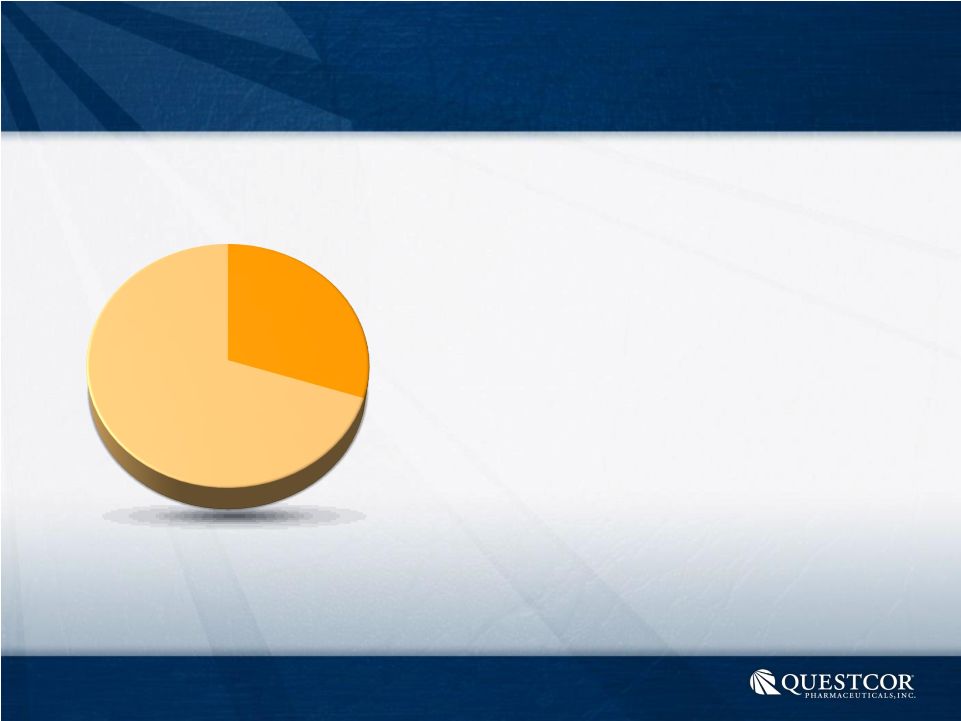 Multiple Sclerosis (MS) Relapse
Adequately
Treated Relapses
Treated Relapses
~70K
~70K
Addressable
Patient
Population
~30K
•
MS is a neurodegenerative disease
occurring in about 400,000 patients
in the US
•
Estimated >100,000 relapses/year
•
Relapses range from mild to severe
and can cause a range of symptoms
–
Loss of sensation in the extremities
–
Loss of vision
–
Loss of ability to walk
•
Relapses can have a measurable
and sustained effect on disability in
MS patients
14
~30,000 Addressable
Annual Relapses (US) |
 •
Devastating, ultra-rare form of childhood epilepsy
•
Can cause permanent developmental disabilities, increased mortality
•
Acthar
is
often
considered
the
“gold
standard”
and
is
currently
used to treat ~50% of IS patients
Infantile Spasms (IS)
Acthar
Penetration
~780 Pts
15
~1,500 Patients (US) |
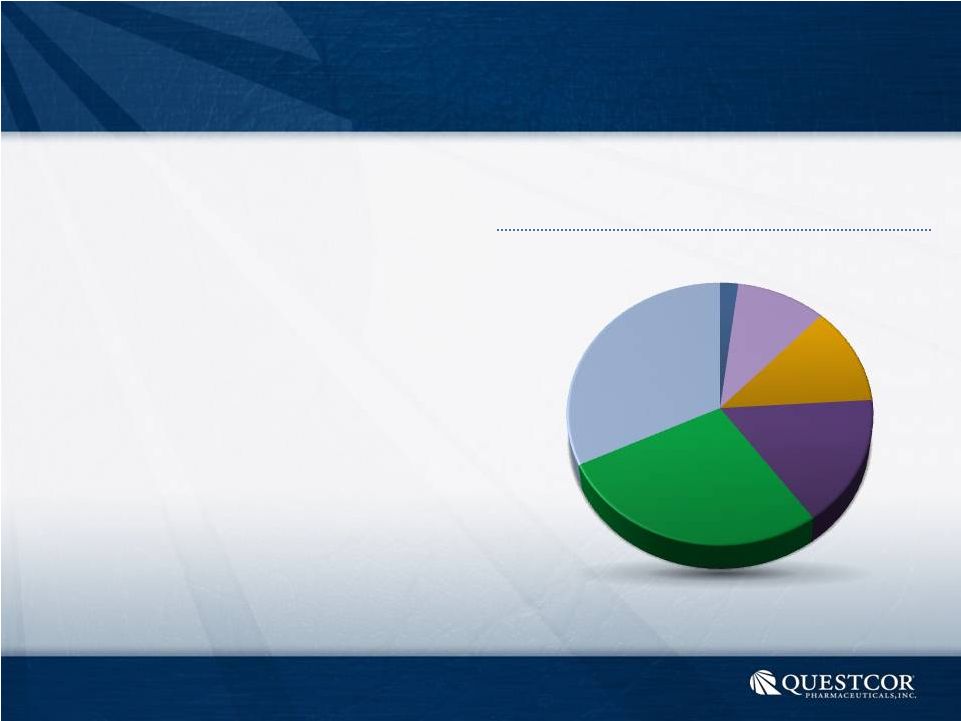 Rheumatology
Rheumatology
Acthar’s Largest Market Opportunity
Acthar’s Largest Market Opportunity
DM/PM
DM/PM
RA
RA
jRA
jRA
Lupus
Lupus
PsA
PsA
AS
AS
16
*See http://www.acthar.com/files/Acthar-PI.pdf for specific label information.
Approximately 250,000 combined patients
(US) are believed to be in need of additional
treatment options
•
Rheumatology-related indications
on the Acthar label*
–
Dermatomyositis/Polymyositis
–
Systemic lupus erythematosus
–
Rheumatoid
arthritis
-
adjunctive
therapy
or in selected cases low-dose
maintenance therapy
–
Psoriatic
arthritis
–
short
term
adjunctive
–
Ankylosing
spondylitis
–
short
term
adjunctive
•
Each can pose a serious health risk if not
adequately controlled
•
Some cases difficult to manage;
Acthar is an additional FDA-approved
treatment option
•
Positive initial uptake; expanded Rheum
Sales Force from 12 to 62 reps |
 Initiating a Pilot Commercialization Effort
Initiating a Pilot Commercialization Effort
in Pulmonology
in Pulmonology
•
•
Acthar is approved for the
Acthar is approved for the
treatment of respiratory
treatment of respiratory
manifestations of symptomatic
manifestations of symptomatic
sarcoidosis
sarcoidosis
–
–
A systemic inflammatory disease
A systemic inflammatory disease
where cell nodules or granulomas
where cell nodules or granulomas
can manifest in multiple organs, most
can manifest in multiple organs, most
often in the lungs
often in the lungs
–
–
Cause is unknown
Cause is unknown
–
–
May be asymptomatic or
May be asymptomatic or
chronic and may cause death;
chronic and may cause death;
difficult to treat
difficult to treat
17
Asymptomatic
Asymptomatic
or Adequately
or Adequately
Treated
Treated
~130K
~130K
Potential
Potential
Acthar Patients
Acthar Patients
~20K
~20K
~20,000 Addressable Patients (US)
~20,000 Addressable Patients (US) |
 Indication
Indication
Potential Acthar
Potential Acthar
Patient Population
Patient Population
% Acthar Penetration
% Acthar Penetration
(estimated)
(estimated)
Large Addressable Markets with
Large Addressable Markets with
Growth Potential (U.S. Only)
Growth Potential (U.S. Only)
18
Note: Amounts and percentages based on internal company estimates.
|
 Indication
Indication
Potential Acthar
Potential Acthar
Patient Population
Patient Population
% Acthar Penetration
% Acthar Penetration
(estimated)
(estimated)
NEUROLOGY
NEUROLOGY
Infantile Spasms
Infantile Spasms
1,500
1,500
52%
52%
Large Addressable Markets with
Large Addressable Markets with
Growth Potential (U.S. Only)
Growth Potential (U.S. Only)
19
Note: Amounts and percentages based on internal company estimates.
|
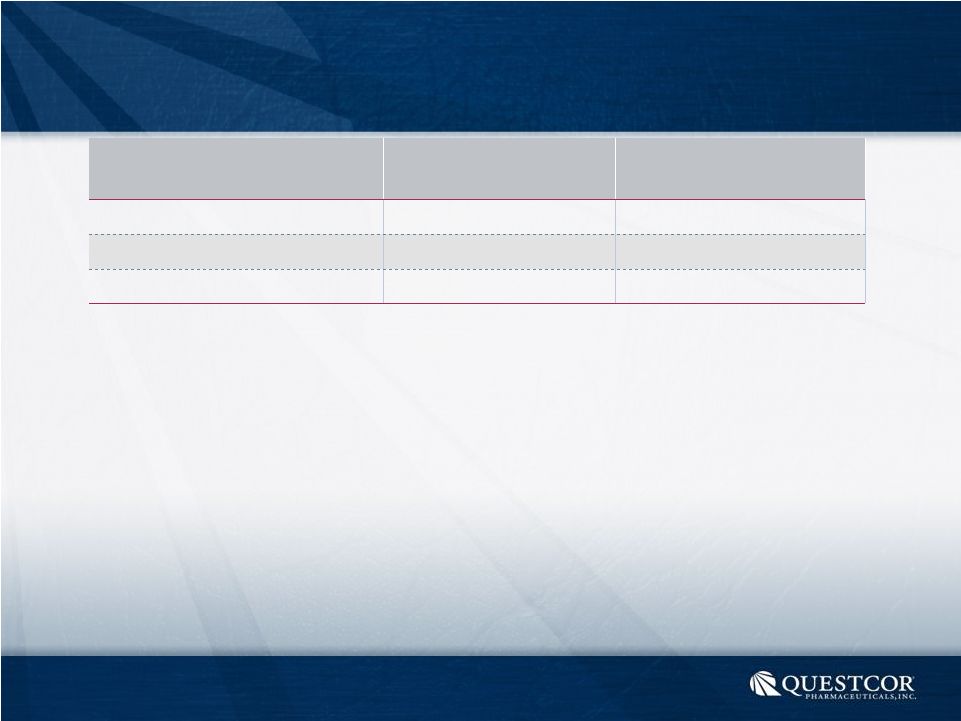 Indication
Indication
Potential Acthar
Potential Acthar
Patient Population
Patient Population
% Acthar Penetration
% Acthar Penetration
(estimated)
(estimated)
NEUROLOGY
NEUROLOGY
Infantile Spasms
Infantile Spasms
1,500
1,500
52%
52%
Multiple Sclerosis Flares
Multiple Sclerosis Flares
30,000
30,000
18%
18%
Large Addressable Markets with
Large Addressable Markets with
Growth Potential (U.S. Only)
Growth Potential (U.S. Only)
20
Note: Amounts and percentages based on internal company estimates.
|
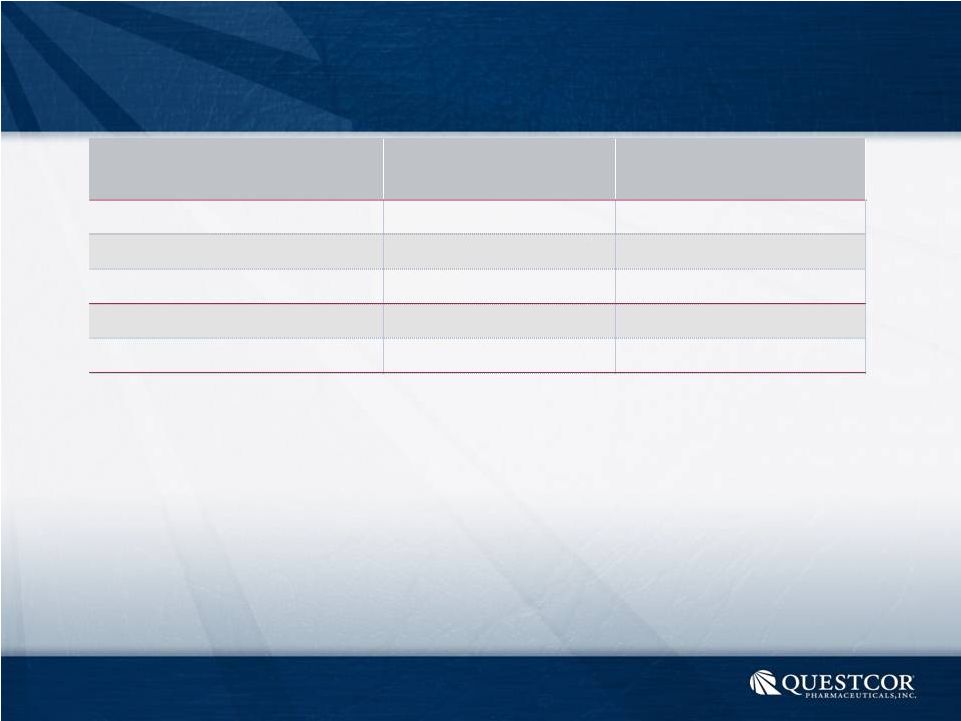 Large Addressable Markets with
Large Addressable Markets with
Growth Potential (U.S. Only)
Growth Potential (U.S. Only)
21
Note:
Amounts
and
percentages
based
on
internal
company
estimates.
Indication
Indication
Potential Acthar
Patient Population
% Acthar Penetration
(estimated)
NEUROLOGY
NEUROLOGY
Infantile Spasms
Multiple Sclerosis Flares
NEPHROLOGY
NEPHROLOGY
Nephrotic Syndrome
1,500
30,000
35,000
35,000
52%
18%
9%
9% |
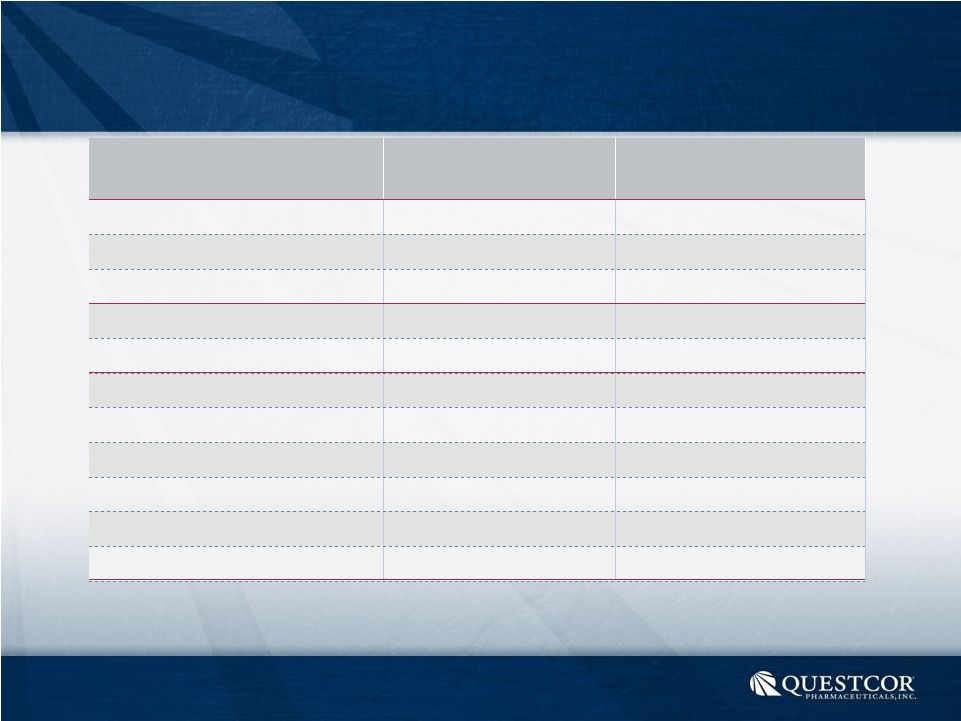 Indication
Indication
Potential Acthar
Potential Acthar
Patient Population
Patient Population
% Acthar Penetration
% Acthar Penetration
(estimated)
(estimated)
NEUROLOGY
NEUROLOGY
Infantile Spasms
Infantile Spasms
1,500
1,500
52%
52%
Multiple Sclerosis Flares
Multiple Sclerosis Flares
30,000
30,000
18%
18%
NEPHROLOGY
NEPHROLOGY
Nephrotic Syndrome
Nephrotic Syndrome
35,000
35,000
9%
9%
RHEUMATOLOGY
RHEUMATOLOGY
PM/DM
PM/DM
20,000
20,000
2%
2%
Rheumatoid Arthritis
Rheumatoid Arthritis
80,000
80,000
0.5%
0.5%
Lupus
Lupus
70,000
70,000
0.4%
0.4%
Ankylosing spondylitis
Ankylosing spondylitis
50,000
50,000
0.04%
0.04%
Psoriatic arthritis
Psoriatic arthritis
30,000
30,000
0.2%
0.2%
Large Addressable Markets with
Large Addressable Markets with
Growth Potential (U.S. Only)
Growth Potential (U.S. Only)
22
Note: Amounts and percentages based on internal company estimates.
|
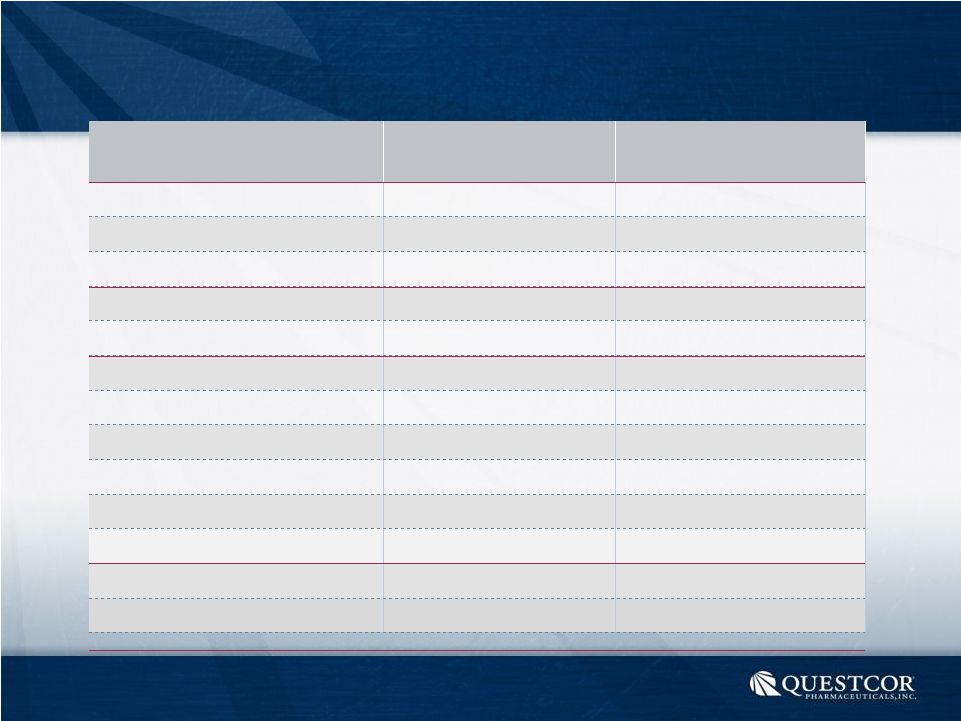 Indication
Indication
Potential Acthar
Potential Acthar
Patient Population
Patient Population
% Acthar Penetration
% Acthar Penetration
(estimated)
(estimated)
NEUROLOGY
NEUROLOGY
Infantile Spasms
Infantile Spasms
1,500
1,500
52%
52%
Multiple Sclerosis Flares
Multiple Sclerosis Flares
30,000
30,000
18%
18%
NEPHROLOGY
NEPHROLOGY
Nephrotic Syndrome
Nephrotic Syndrome
35,000
35,000
9%
9%
RHEUMATOLOGY
RHEUMATOLOGY
PM/DM
PM/DM
20,000
20,000
2%
2%
Rheumatoid Arthritis
Rheumatoid Arthritis
80,000
80,000
0.5%
0.5%
Lupus
Lupus
70,000
70,000
0.4%
0.4%
Ankylosing spondylitis
Ankylosing spondylitis
50,000
50,000
0.04%
0.04%
Psoriatic arthritis
Psoriatic arthritis
30,000
30,000
0.2%
0.2%
PULMONOLOGY
PULMONOLOGY
Sarcoidosis
Sarcoidosis
20,000
20,000
0.2%
0.2%
Large Addressable Markets with
Large Addressable Markets with
Growth Potential (U.S. Only)
Growth Potential (U.S. Only)
23
Note: Amounts and percentages based on internal company estimates.
|
 Synacthen (tetracosactide) Overview
Synacthen (tetracosactide) Overview
24
•
•
Acquired license to develop and commercialize Synacthen and
Acquired license to develop and commercialize Synacthen and
Synacthen Depot in U.S.
Synacthen Depot in U.S.
•
•
Rights to develop and commercialize in over three dozen countries*
Rights to develop and commercialize in over three dozen countries*
–
–
Opportunity to reinvigorate Synacthen and provides platform for
Opportunity to reinvigorate Synacthen and provides platform for
potential international growth
potential international growth
•
•
Expands presence in inflammatory and autoimmune disorders
Expands presence in inflammatory and autoimmune disorders
–
–
Provides foundation for next generation melanocortin peptide therapeutics
Provides foundation for next generation melanocortin peptide therapeutics
•
•
Further diversifies business
Further diversifies business
*Subject to certain closing conditions |
 Advancing Our Understanding of Acthar
Advancing Our Understanding of Acthar
and Melanocortin Peptides
and Melanocortin Peptides
25
•
•
One of 9 families of hormones produced by the pituitary,
One of 9 families of hormones produced by the pituitary,
the “master gland”
the “master gland”
•
•
Believed to modulate the immune system and associated
Believed to modulate the immune system and associated
inflammatory process through binding to 5 melanocortin receptors
inflammatory process through binding to 5 melanocortin receptors
–
–
MC1R, MC2R, MC3R, MC4R, and MC5R
MC1R, MC2R, MC3R, MC4R, and MC5R
–
–
Differences in chemical structure influence binding affinity
Differences in chemical structure influence binding affinity
•
•
Questcor currently has two distinct melanocortin-peptide
Questcor currently has two distinct melanocortin-peptide
based products
based products
–
–
Acthar (porcine ACTH 1-39); Synacthen (tetracosactide)
Acthar (porcine ACTH 1-39); Synacthen (tetracosactide)
|
 Acthar Mechanism of Action
Acthar Mechanism of Action
26
•
Clinical observations
–
Acthar has been shown to have increased
efficacy vs. corticosteroids in infantile spasms
–
Acthar has been successfully used to induce
remission of proteinuria in nephrotic syndrome
without uremia of the idopathic type
(e.g., iMN, FSGS, IgA nephropathy)
1
•
Preclinical observations demonstrate
steroid-independent
anti-inflammatory,
immuno-modulatory properties of
ACTH & other MC peptides
2
1: Bomback et al, Am J Nephrol 2012;36:58–67
2: Gong et al, Kidney International, 83, January 2013
|
 Implications of Acthar and Other Melanocortins
Implications of Acthar and Other Melanocortins
(Synacthen and new MCs)
(Synacthen and new MCs)
27
•
•
We now believe Acthar and other melanocortin peptides impact
We now believe Acthar and other melanocortin peptides impact
–
–
Immune system
Immune system
–
–
Inflammatory process
Inflammatory process
–
–
Some cell function
Some cell function
–
–
Homeostasis
Homeostasis
•
•
Dozens of moderate-to-severe medical conditions may benefit from
Dozens of moderate-to-severe medical conditions may benefit from
Acthar or other melanocortin peptide therapeutics
Acthar or other melanocortin peptide therapeutics |
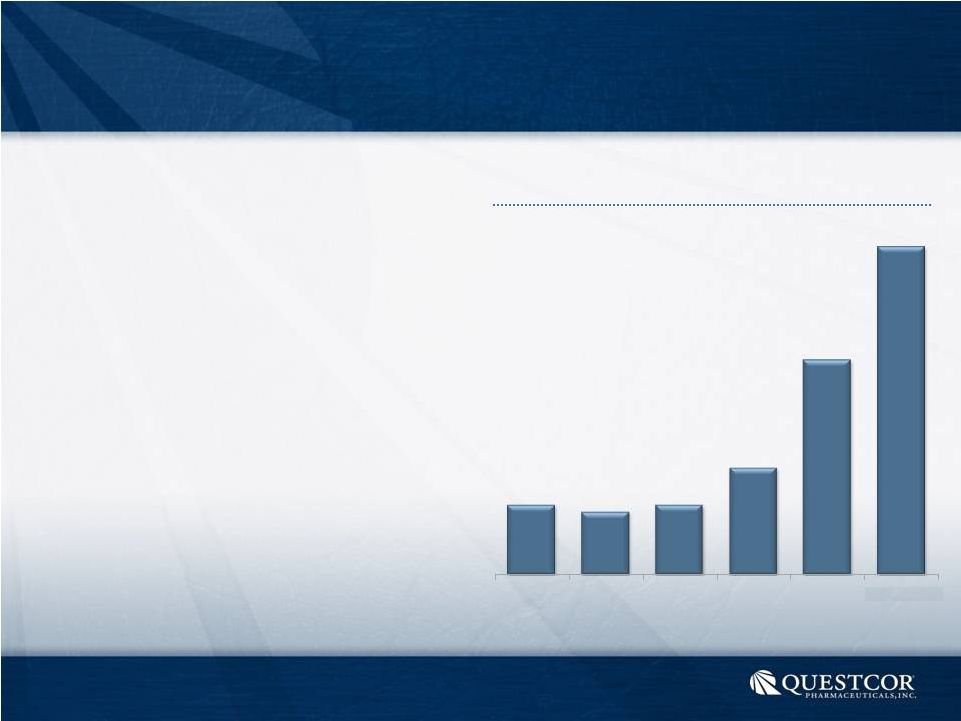 Significantly Increasing Investment in R&D
Significantly Increasing Investment in R&D
•
Have funded or have approved
funding for studies covering
both on label and potential
new indications
–
Company sponsored pre-clinical
and clinical studies
–
Independent physician sponsored
studies
•
Investigating potential biological
properties of Acthar
–
Direct effect on biochemical
pathways, cells and tissues
–
Immunomodulation and
anti-inflammatory properties
28
R&D Investment ($M)
TTM 2013: Trailing twelve months through September 30, 2013
$11
$10
$11
$17
$34
$52
2008
2009
2010
2011
2012
TTM
2013 |
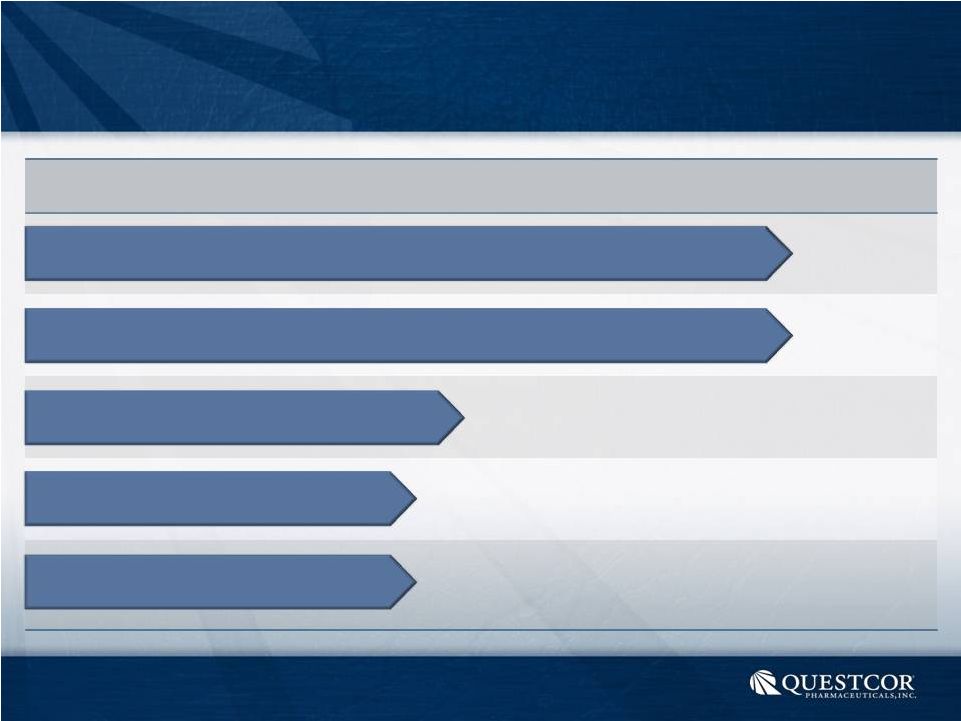 Expanding the Body of Evidence for
Expanding the Body of Evidence for
On-Label and New Indications/Targets
On-Label and New Indications/Targets
29
IDIOPATHIC MEMBRANOUS NEPHROPATHY
IDIOPATHIC MEMBRANOUS NEPHROPATHY
SYSTEMIC LUPUS ERYTHEMATOSUS
SYSTEMIC LUPUS ERYTHEMATOSUS
DIABETIC NEPHROPATHY
DIABETIC NEPHROPATHY
AMYOTROPHIC LATERAL SCLEROSIS
AMYOTROPHIC LATERAL SCLEROSIS
ACUTE RESPIRATORY DISTRESS
ACUTE RESPIRATORY DISTRESS
SYNDROME
SYNDROME
Pre-Clinical
Phase 1
Phase 2
Phase 4
Phase 3 |
 ALS
Phase 2 Open-Label Safety Study for ALS Phase 2 Open-Label Safety
Study for Acthar
Acthar
30
•
•
Goals
Goals
–
–
Assess short-term safety and tolerability of Acthar in ALS
Assess short-term safety and tolerability of Acthar in ALS
–
–
Inform dosage selection for future studies
Inform dosage selection for future studies
•
•
Study Design
Study Design
–
–
Enroll up to 40 patients at multiple sites in U.S.
Enroll up to 40 patients at multiple sites in U.S.
–
–
8-week treatment, plus optional 28-week open label extension
8-week treatment, plus optional 28-week open label extension
–
–
Patients randomized to one of four dosing regimens
Patients randomized to one of four dosing regimens
Findings to Drive Design for Pivotal Efficacy Study
Findings to Drive Design for Pivotal Efficacy Study |
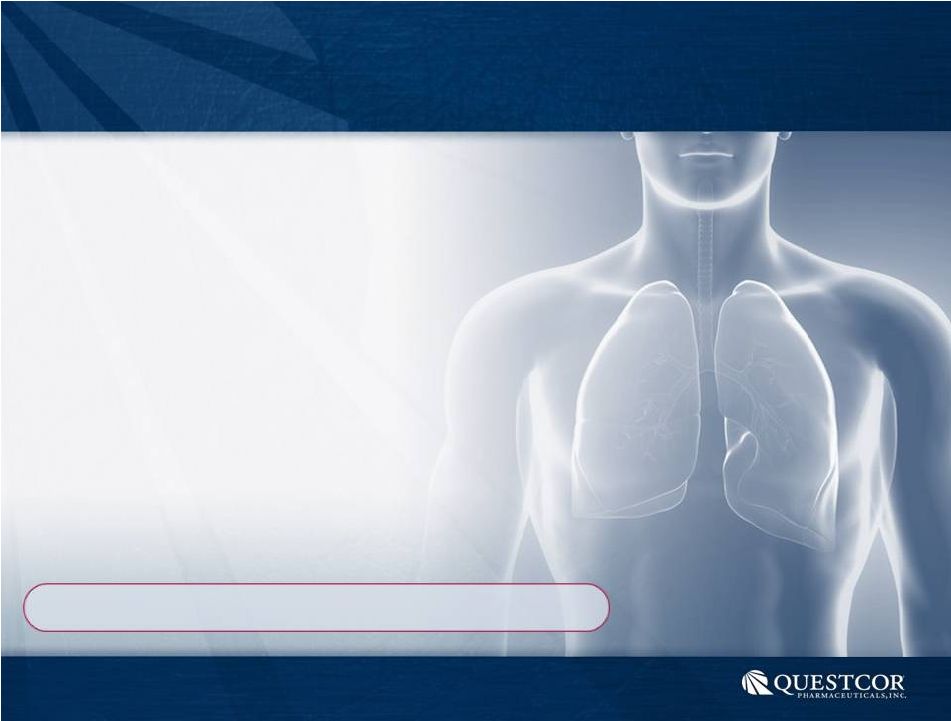 ARDS Phase 2 Safety and Efficacy Study for
ARDS Phase 2 Safety and Efficacy Study for
Acthar
Acthar
31
•
•
Goals
Goals
–
–
Determine if Acthar increases number of
Determine if Acthar increases number of
ventilator-free days during 28-day
ventilator-free days during 28-day
treatment period
treatment period
–
–
Assess if Acthar reduces mortality,
Assess if Acthar reduces mortality,
organ failure, length of hospital or ICU stay
organ failure, length of hospital or ICU stay
–
–
Inform dosage selection for future studies
Inform dosage selection for future studies
•
•
Study Design
Study Design
–
–
4-week randomized, placebo controlled trial
4-week randomized, placebo controlled trial
–
–
Enroll up to 210 patients at up to 40 sites in U.S.
Enroll up to 210 patients at up to 40 sites in U.S.
–
–
Patients randomized to one of six dosing regimens
Patients randomized to one of six dosing regimens
Findings to Drive Design for Pivotal Efficacy Study
Findings to Drive Design for Pivotal Efficacy Study |
 Strong Platform for Growth
Strong Platform for Growth
32
•
Increasing penetration of current Acthar markets and expanding sales into
new, approved indications
–
NS and MS market penetration remains modest
–
Rheumatology
is
a
new
Acthar
market
in
very
early
development;
growing
rapidly
–
Pilot selling effort in pulmonology for symptomatic sarcoidosis
–
Possible
Acthar
role
in
dermatology
and
ophthalmology
indications
being
evaluated for commercial potential
•
Untapped international market opportunities
–
Developing international markets for Synacthen and Acthar
•
Developing
new
indications
for
Acthar,
Synacthen
and
potentially
other
melanocortin therapeutics
•
Strong free cash flow generation enables possible product
acquisitions/partnering |
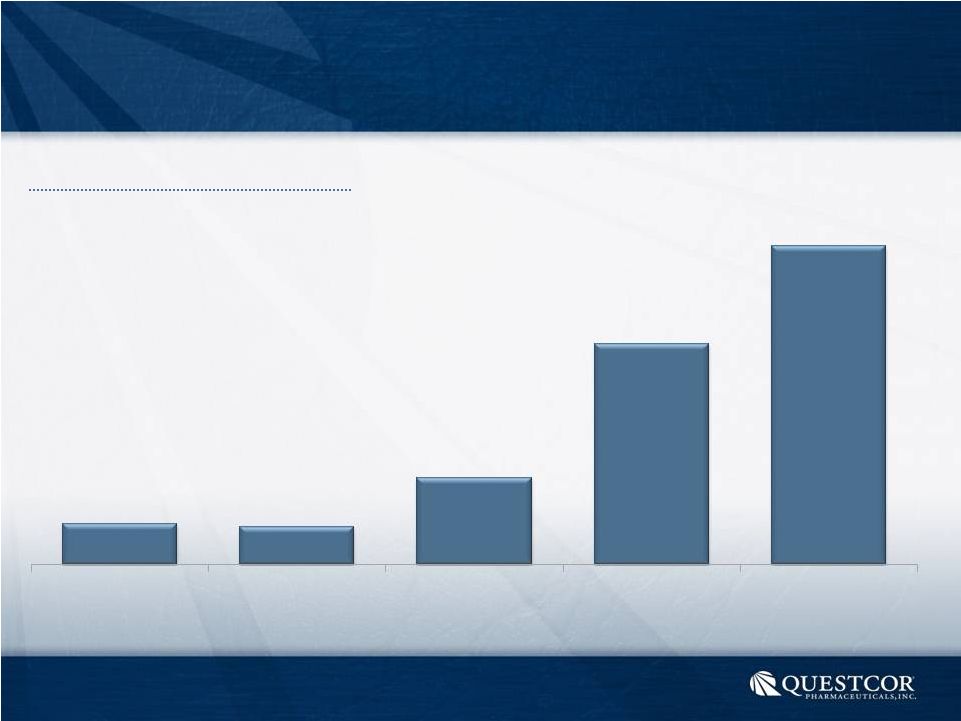 Growing Cash Flow
Growing Cash Flow
33
TTM 2013: Trailing twelve months through September 30, 2013
Operating Cash Flow ($M)
$40
$37
$86
$219
$316
2010
2011
2012
2013TTM
2009 |
 Committed to Creating Long Term Value
Committed to Creating Long Term Value
for Shareholders
for Shareholders
34
•
•
Continued stewardship of Acthar and Synacthen
Continued stewardship of Acthar and Synacthen
•
•
Demonstrated ability to execute
Demonstrated ability to execute
•
•
Long
Long
term
term
investment
investment
in
in
R&D
R&D
--
--
doubled
doubled
R&D
R&D
spending
spending
in
in
2012
2012
and
and
2013
2013
(projected)
(projected)
•
•
Highly selective, strategic diversification
Highly selective, strategic diversification
•
•
Have returned $465 million to shareholders through share repurchases
Have returned $465 million to shareholders through share repurchases
and dividends
and dividends
–
–
23.1 million shares repurchased
23.1 million shares repurchased
–
5.3
million
shares
remain
available
for
repurchase
under
share
repurchase
program*
•
•
Quarterly dividend increased twice during 2013; $0.30/share
Quarterly dividend increased twice during 2013; $0.30/share
|
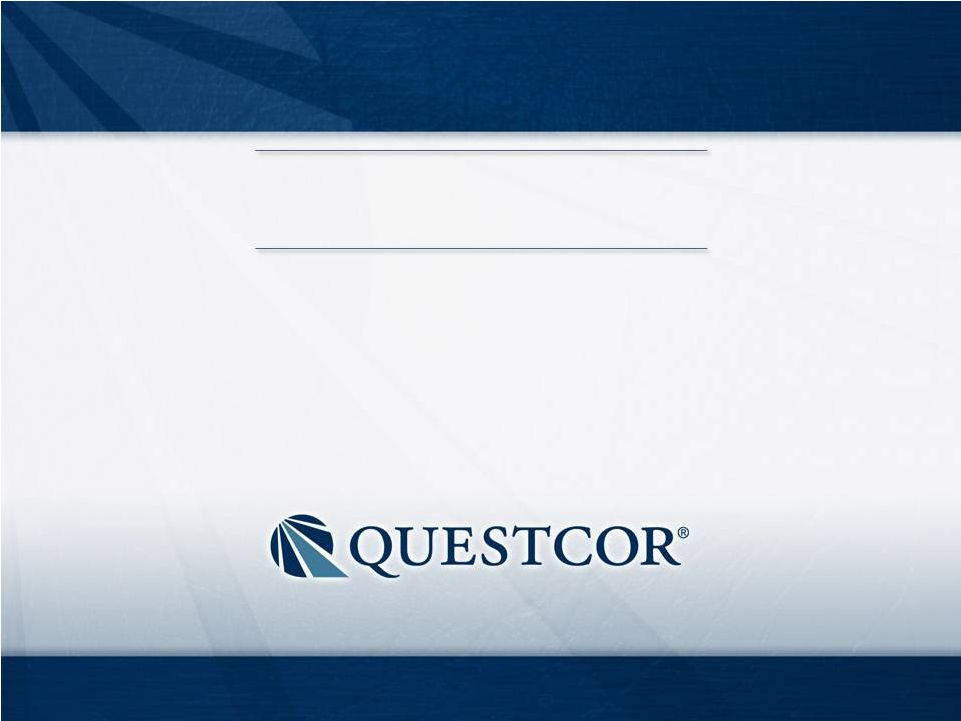 NASDAQ:
NASDAQ:
QCOR
QCOR
January 2014
January 2014 |
 Net income per share
– basic and diluted may not foot
due to rounding
Use of Non-GAAP Financial Measures
Our “non-GAAP adjusted net income”
excludes
the
following items from
GAAP net income:
1. Share-based compensation expense
3. Interest expense associated with the net present value adjustment on
our contingent consideration
4. Interest expense associated with the net present value adjustment on
the R&D liability in conjunction with acquisition of Synacthen
5. Compensation expense associated with the BV Trust agreement
6. Foreign currency transaction loss
9. Impairment of purchased technology related to our
acquisition of Doral
Reconciliation of Non-GAAP Adjusted
Financial Disclosure
36
Three Months
Ended
September 30,
Nine Months
Ended
September 30,
2013
2012
2013
2012
Adjusted net income
$104,36
8
$59,427
$233,32
8
$143,94
3
Share-based compensation expense (1)
(5,269)
(2,855)
(13,807)
(6,908)
Depreciation and amortization expense (2)
(3,127)
(226)
(6,253)
(638)
Interest expense associated with contingent consideration (3)
(188)
0
(572)
0
Interest expense associated with R&D liability in conjunction with
(1,141)
0
(1,140)
0
Compensation expense associated with BV Trust (5)
(202)
0
(534)
0
Foreign currency transaction loss (6)
0
0
(329)
0
0
0
(7,751)
0
BioVectra
purchase price adjustment (8)
0
0
169
0
Impairment of purchased technology (9)
0
(659)
(485)
(662)
Net
income
–
GAAP
$94,441
$55,687
$202,62
6
$135,73
5
Adjusted
net
income
per
share
-
basic
$1.77
$1.01
$4.00
$2.36
Share-based compensation expense (1)
(0.09)
(0.05)
(0.24)
(0.11)
Depreciation and amortization expense (2)
(0.05)
0.00
(0.11)
(0.01)
Interest expense associated with contingent consideration (3)
0.00
—
(0.01)
—
Interest expense associated with R&D liability in conjunction with
(0.02)
(0.02)
Compensation expense associated with BV Trust (5)
0.00
—
(0.01)
—
Foreign currency transaction loss (6)
—
—
(0.01)
—
—
—
(0.13)
—
BioVectra purchase price adjustment (8)
—
—
0.00
—
Impairment of purchased technology (9)
—
(0.01)
(0.01)
(0.01)
Net
income
per
share
–
basic
$1.60
$0.95
$3.47
$2.23
Adjusted
net
income
per
share
-
diluted
$1.68
$0.97
$3.82
$2.25
Share-based compensation expense (1)
(0.08)
(0.05)
(0.23)
(0.11)
Depreciation and amortization expense (2)
(0.05)
0.00
(0.10)
(0.01)
Interest expense associated with contingent consideration (3)
0.00
—
(0.01)
—
Interest expense associated with R&D liability in conjunction with
(0.02)
(0.02)
Compensation expense associated with BV Trust (5)
0.00
—
(0.01)
—
Foreign currency transaction loss (6)
—
—
(0.01)
—
—
—
(0.13)
—
BioVectra purchase price adjustment (8)
—
—
0.00
—
Impairment of purchased technology (9)
—
(0.01)
(0.01)
(0.01)
Net
income
per
share
–
diluted
$1.52
$0.91
$3.32
$2.12
Net
sales
–
Questcor
$227,29
6
$140,33
9
$531,11
3
$348,76
0
Net sales -
BioVectra
9,050
0
24,935
0
Consolidated net sales
236,346
140,339
556,048
348,760
Medicaid adjustment
0
0
11,500
0
Adjusted consolidated net sales
$236,34
6
$140,33
9
$567,54
8
$348,76
0
2. Depreciation and amortization expense, including amortization
expense on our purchased intangibles
8. BioVectra purchase price adjustment related to a labor rebate
received in the second quarter 2013
Notes to Reconciliation of Non-GAAP Adjusted Financial
Disclosure
acquisition of Synacthen
(4)
7. Medicaid
adjustment
for
prior
period
2002
-
2009
Medicaid
adjustment
for
2002
-
2009
(7)
acquisition
of
Synacthen
(4)
acquisition of Synacthen
(4)
Medicaid
adjustment
for
2002
-
2009
(7)
Medicaid
adjustment
for
2002
-
2009
(7) |
 Reconciliation of Non-GAAP Adjusted
Reconciliation of Non-GAAP Adjusted
Financial Disclosure
Financial Disclosure
37
2009
2010
2011
2012
TTM 2013
Adjusted
Net
Income
$29,242
$38,988
$83,956
$209,644
$299,033
Stock-based
Compensation
(2,310)
(2,649)
(5,128)
(10,502)
(17,396)
Depreciation
&
Amortization
Expense
(303)
(352)
(731)
(811)
(6,428)
Other
non-cash
expense
(income)
related
to
acquisition
of
BioVectra
0
0
0
0
(1,266)
Other
non-cash
expense
(income)
related
to
acquisition
of
Synacthen
0
0
0
0
(1,140)
Medicaid
adjustment
for
2002-2009
0
0
0
0
(7,751)
Tax
adjustments
0
(916)
1,702
0
0
Impairment
of
goodwill
0
0
(209)
(656)
(485)
GAAP
Net
Income
$26,629
$35,071
$79,591
$197,675
$264,566
Adjusted
Net
Income
per
Share
-
Basic
0.46
$
0.63
$
1.34
$
3.48
$
5.12
$
Stock-based
Compensation
(0.04)
(0.04)
(0.08)
(0.17)
(0.30)
Depreciation
&
Amortization
Expense
(0.00)
(0.01)
(0.01)
(0.01)
(0.11)
Other
non-cash
expense
(income)
related
to
acquisition
of
BioVectra
-
-
-
-
(0.02)
Other
non-cash
expense
(income)
related
to
acquisition
of
Synacthen
-
-
-
-
(0.02)
Medicaid
adjustment
for
2002-2009
-
-
-
(0.13)
Ohio
CAT
-
(0.01)
0.03
-
-
Impairment
of
goodwill
-
-
(0.00)
(0.01)
(0.01)
GAAP
Net
Income
per
Share
-
Basic
0.41
$
0.56
$
1.27
$
3.28
$
4.54
$
Adjusted
Net
Income
-
per
Share
Diluted
0.44
$
0.60
$
1.27
$
3.33
$
4.89
$
- |
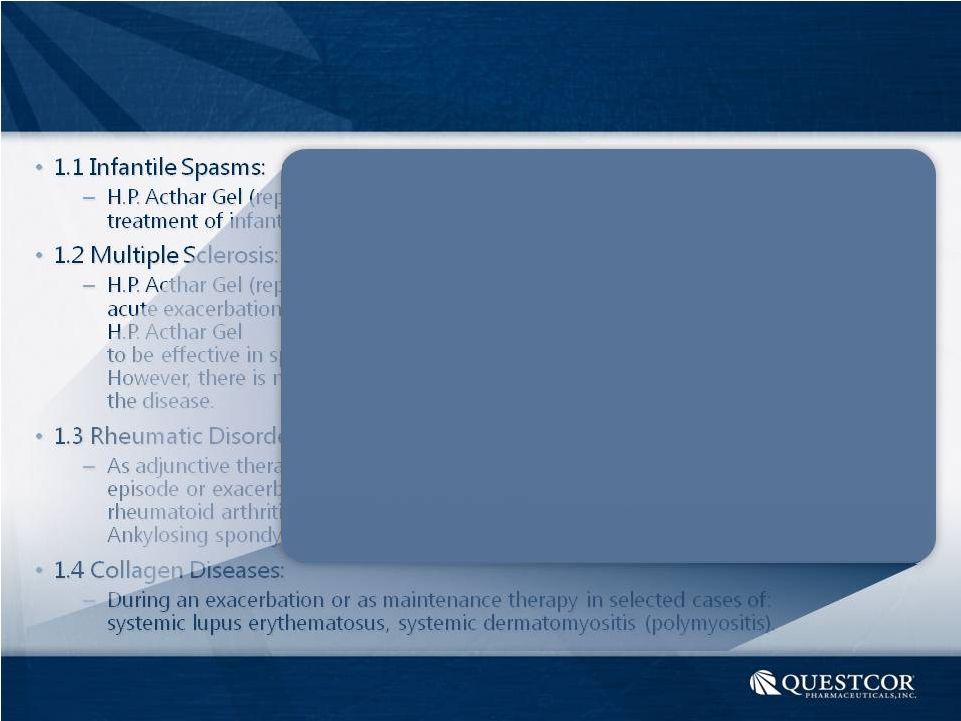 Strong Platform for Growth
Strong Platform for Growth
38
•
1.3 Rheumatic Disorders:
–
As adjunctive therapy for short-term administration
(to tide the patient over an acute episode or exacerbation)
in: Psoriatic arthritis; Rheumatoid arthritis, including
juvenile rheumatoid arthritis (selected cases may require
low-dose maintenance therapy);
Ankylosing spondylitis.
•
1.4 Collagen Diseases:
–
During an exacerbation or as maintenance therapy in
selected cases of: systemic lupus erythematosus,
systemic dermatomyositis (polymyositis). |
 How
Does Acthar Work? How Does Acthar Work?
39
•
Treats autoimmune/inflammatory process associated with the
pathophysiology
•
By binding to melanocortin receptors, may modulate the immune
system and associated inflammatory process
1,5-9
•
Triggers the production of cortisol and other adrenal compounds
through binding to MC2R receptors found in the adrenal cortex
•
Properties extend beyond steroidogenesis
1,5-9
•
Acthar
components
have
yet
to
be
fully
characterized
10
1
Arnason
et
al.
Mult
Sclerosis
J.
2012;
2
Arya
et
al.
J
Child
Neuro
2012;
3
Bomback
et
al.
Amer
J.
Neph
2012;
4
Levine,
Drug
Design,
Dev
&
Therapy,
2012.
5
Catania, et al. Pharmacol Rev. 2004;
6
Stafstrom, et al. J Child Neuro 2011;
7
Manna SK, J Immunol. 1998;
8
Gong R. Nat Rev Nephrol. 2011;
9
Bohm et al. Endocrine Reviews 2012; 10H.P. Acthar Gel package insert. Questcor
Pharmaceuticals, Inc., 2011. Binds to melanocortin receptors found on immune
cells Binds
to
cells
in
many
types
of
tissues
(e.g.,
kidney
podocytes)
1,3,5,6,8,9
ACTH is believed to be the primary active component in Acthar,
but there may be others
1-4 |
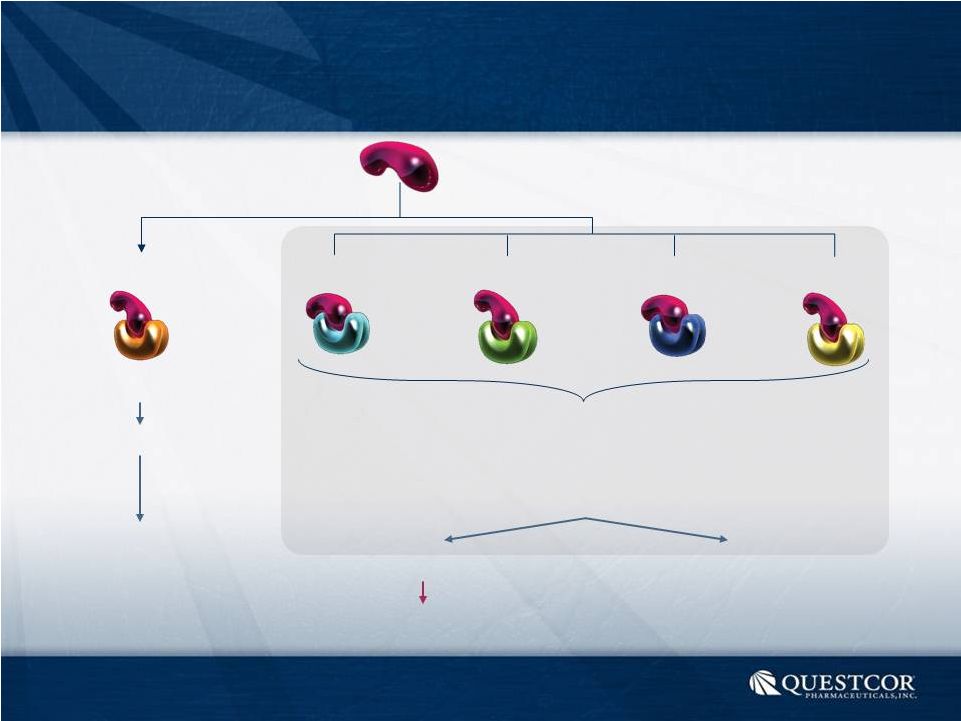 Melanocortin Peptides May Activate Up to
Melanocortin Peptides May Activate Up to
Five Known Melanocortin Receptors
Five Known Melanocortin Receptors
40
Steroid-dependent
anti-inflammatory
effects (indirect)
MC2R
MC2R
Corticosteroids
Adrenal cortical cells
MC1R
MC1R
MC3R
MC3R
MC4R
MC4R
MC5R
MC5R
Altered tissue/organ & cell
Altered tissue/organ & cell
function
function
Direct effect on organ-specific
cells
(eg, CNS, kidney, muscle)
(eg, CNS, kidney, muscle)
Effects on immune cells
Effects on immune cells
Immune cells, CNS cells, kidney cells, muscle cells,
many other cells
Acthar
Acthar
Steroid-independent anti-inflammatory/immunomodulatory effects |
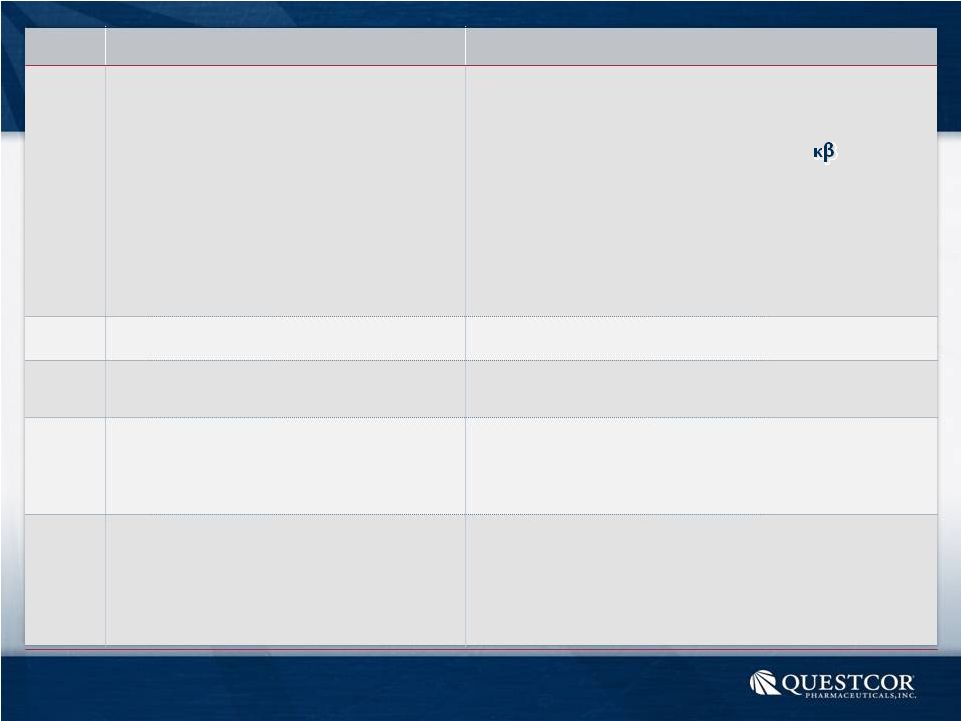 41
MCR
Tissue/Cell Expression
Potential biologic activity
MC1R
Podocytes
Renal Mesangial Cells
Endothelial Cells (Glomerular,
Tubular, Vascular)
Macrophages, Monocytes, Neutrophils
Melanocytes
Keratinocytes
Central Nervous System
Chondrocytes
Respiratory tract
GI tract
•
Immunomodulation (including modulation of
antigen presentation; immune cell adhesion and
trafficking;
dampen
autoimmunity;
NF-
sequestration)
•
Cytoprotection (reduction of oxidative stress)
•
Ischemia-reperfusion
protection
Protection
from
LPS
-induced systemic inflammatory response
•
Cytoskeletal effects (regulate expression of
collagen, vimentin, podocyte specific proteins)
MC2R
Adrenal Cortex, Adipocytes, Testis
•
Steroidogenesis
MC3R
Central Nervous System
Macrophages
•
Immunomodulation
•
Protection from ischemia
MC4R
Podocytes
Renal Mesangial Cells
Central Nervous System
•
Regulation of
neuroinflammation
•
•
Metabolic control
MC5R
Central Nervous System
Exocrine Glands
Lymphocytes
•
Immunomodulation
•
B cell signaling
•
Exocrine secretion
•
Ocular immunity
•
Lipid regulation
Cerebral ischemic protection
Endothelial Cells (Glomerular, Tubular) |
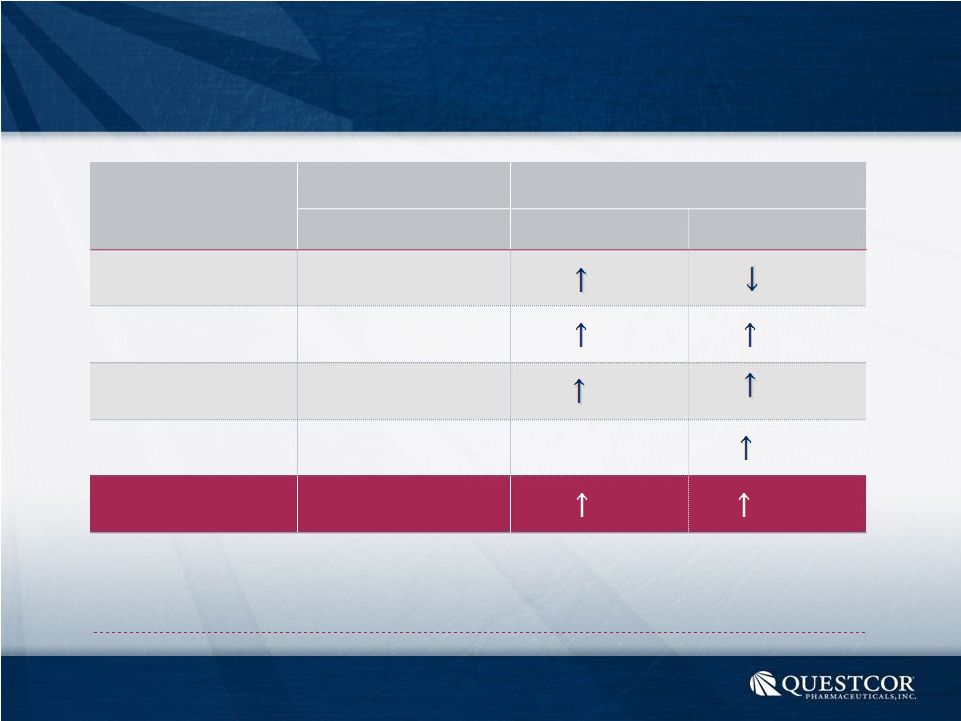 *
Includes
prescriptions
covered
by
commercial
carriers,
Medicare,
Medicaid
and
Tricare
in all
periods regardless of the rebate percentage applicable in those periods.
**
Total number of prescriptions includes all paid prescriptions.
Based on internal company estimates
New Paid Acthar Prescriptions
New Paid Acthar Prescriptions
by Therapeutic Area*
by Therapeutic Area*
42
Paid Rx
Comparison
Q3 –
2013
Q3 –
2012
Q2 –
2013
NS
370 -
380
7%
7%
7%
7%
MS
IS
IS
Rheumatology
1,370 -
1,400
225 -
230
450 -
460
4%
8%
33%
7%
N/M
Total
2,450 -
2,500**
30%
10%
43% |
 Biosimilar Pathways Highly Challenging
Biosimilar Pathways Highly Challenging
43
•
•
Complex formulation and pharmacology, with multiple receptor
Complex formulation and pharmacology, with multiple receptor
binding properties
binding properties
–
–
Possibly multiple active peptides
Possibly multiple active peptides
–
–
Slow release gel formulation
Slow release gel formulation
–
–
Complex and not well characterized (research is ongoing)
Complex and not well characterized (research is ongoing)
•
•
Formulation and manufacturing trade secrets inherent with Acthar
Formulation and manufacturing trade secrets inherent with Acthar
•
•
Future synthetic versions of ACTH might be possible, but in a
Future synthetic versions of ACTH might be possible, but in a
specific indication
specific indication
–
–
Clinical trial(s) and other development work likely required
Clinical trial(s) and other development work likely required
–
–
Multi-year pathway; challenging IP landscape
Multi-year pathway; challenging IP landscape |
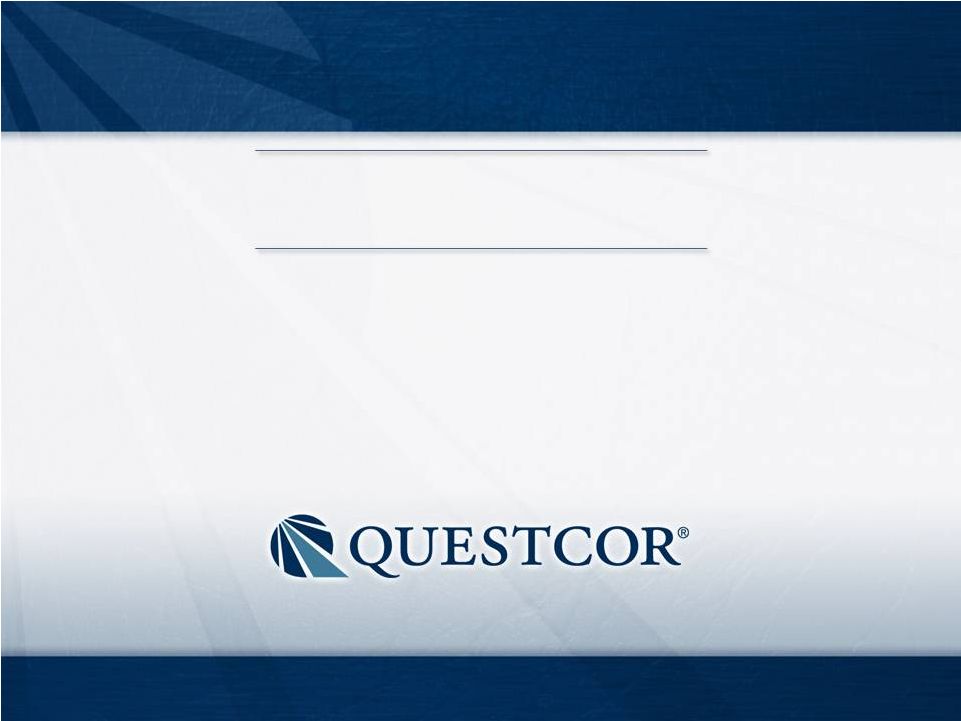 NASDAQ:
NASDAQ:
QCOR
QCOR
January 2014
January 2014 |
